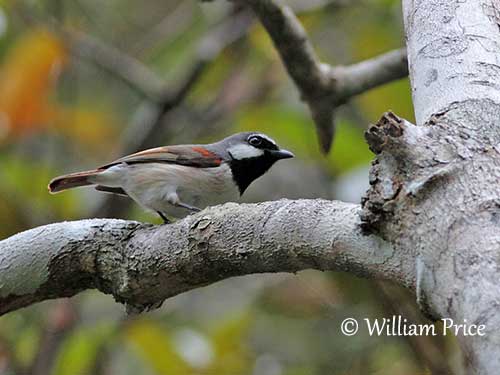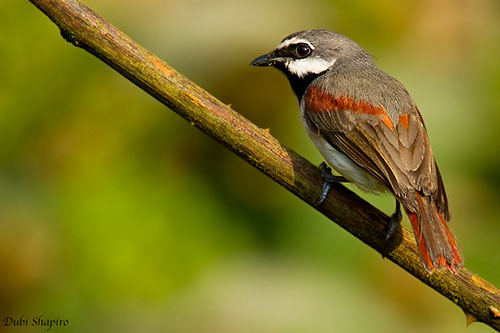
Fr: Calicalic malgache
Ang: Red-tailed Vanga
All: Rotschwanzvanga
Esp: Vanga Colirrojo
Ita: Vanga codarossa
Nd: Roodstaartvanga
Sd: rödstjärtad vanga
Mal: hankana, Totkarasoka, Totokarasoka
Photographers:
John Anderson
John Anderson Photo Galleries
William Price
PBase-tereksandpiper & Flickr William Price
Dubi Shapiro
Dubi Shapiro Photo Galleries & Dubi Shapiro's Pictures on IBC
Text by Nicole Bouglouan
Sources :
HANDBOOK OF THE BIRDS OF THE WORLD Vol 14 by Josep del Hoyo-Andrew Elliot-David Christie - Lynx Edicions – ISBN: 9788496553507
Birds of Madagascar and the Indian Ocean Islands Par Roger Safford, Adrian Skerrett, Frank Hawkins – ISBN: 1472924118, 9781472924117- Editeur: Bloomsbury Publishing, 2015
Birds of Madagascar: A Photographic Guide Par Pete Morris, Frank Hawkins – ISBN: 0300077556, 9780300077551- Editeur: Yale University Press, 1998
Birds of the Indian Ocean Islands Par Ian Sinclair, Olivier Langrand - ISBN: 1868729567, 9781868729562- Editeur: Struik, 2003
A Photographic Guide to Birds of the Indian Ocean Islands: Madagascar ... Par Ian Sinclair, Olivier Langrand, Fanja Andriamialisoa - ISBN-10: 177007175X - ISBN-13: 978-1770071759 - Publisher: Struik Publishers (July 18, 2011)
Wildlife of Madagascar par Ken Behrens,Keith Barnes - ISBN: 140088067X, 9781400880676 – Editeur: Princeton University Press, 2016
Breeding Ecology of the Malagasy Endemic Red-Tailed Vanga Calicalicus madagascariensis
Creagus – Bird Families of the World – Vangas - Vanginae
THE VANGAS OF MADAGASCAR by Nick Garbutt
Red-tailed Vanga
Calicalus madagascariensis
Passeriformes Order – Vangidae Family
INTRODUCTION:
The Red-tailed Vanga is endemic to Madagascar where it frequents several types of forests in N, W and E of the island. This small tit-like vanga is often found in pairs or in small mixed-species groups. It feeds on insects caught by short sallies or gleaned from the vegetation. This species is socially monogamous and both adults share the nesting duties.
The genus Calicalus has been included in Vangidae, but recent molecular analysis places it close to other vanga genera. However, several morphological features suggest that it may not belong in this family at all, but could be closer to Dicruridae and Monarchidae.
This analysis contradicts the DNA evidence for an African origin, and we can suggest that the most recent common ancestor of the vangas reached Madagascar from the east.
The Red-tailed Vanga is relatively common throughout its range, and the species is not currently globally threatened.
DESCRIPTION OF THE BIRD:
Biometrics:
Length: 13-14 cm
Weight: 14-19 g
The Red-tailed Vanga is sexually dimorphic.
The adult male has grey upperparts slightly washed green. On the upperwing, median and lesser coverts are rufous, whereas the primaries are blackish with grey edges. Rump and uppertail-coverts are rufous. The tail is rufous with grey-brown inner webs of central pair of rectrices.
The underparts are white, but flanks and sides of breast are washed pale buff, whereas the thighs are often tinged rufous. On the underwings, the coverts are white.
On the head, forehead, crown and nape are grey. We can see a black patch on lores, extending around the eye, and a narrow, white band above this dark area. Cheeks and ear-coverts are white, contrasting with the black chin and throat.
The bill is black. The eyes are dark brown. Legs and feet are grey.

The adult female is duller overall. The head is pale grey with conspicuous white eyering. The upperparts are olive-brown with rufous rump and uppertail-coverts. The upperwing is dark brown. The tail is rufous with dark brown inner edges to rectrices.
The juvenile resembles female but the feathers show buff shaft streaks and tips on the upperparts.
RANGE:
The Red-tailed Vanga is found in N, W and E Madagascar. The species is very common in the eastern rainforest, but it is more patchily distributed in west.
HABITAT:
The Red-tailed Vanga frequents several types of native forest and adjacent second growth. It is found in the E rainforest and in the W deciduous forest, but it is less common in S subdesert. The species occurs from sea-level up to 1,800 metres of elevation.
CALLS AND SONGS: SOUNDS BY XENO-CANTO
The Red-tailed Vanga male of the eastern forest gives descending “per-whew” similar to human whistle. But in the west, the male utters series of notes with higher last syllable “pew-poo-whee” or “oo-oo-whi”. We can also hear another song type “plee-plee tich che-weh”.
Male and female give repeated wooden “tk-tk trrt” or “trrk tikatik”. The male produces a hissing “kscrrr”.
BEHAVIOUR IN THE WILD:
The Red-tailed Vanga feeds on invertebrates such as insects including Orthopterans, Coleopterans and caterpillars. It also catches small chameleons.
It usually frequents all strata of the forest, usually heading upwards towards the upper level where it forages and gleans invertebrates mainly on small branches. It forages in pairs during the breeding season, or occasionally in small mixed-species groups.

The Red-tailed Vanga is socially monogamous and both parents build the nest together, incubate the eggs and rear the young. However, the male provides more parental care than the female. No helpers have been observed at nest.
The Red-tailed Vanga is probably sedentary. Like most Vangidae, it has short wings and only performs short-distance flights.
REPRODUCTION OF THIS SPECIES:
The Red-tailed Vanga breeds between October and January in Ranomafana National Park.
Both adults take part in nest-building. They build a cup-shaped structure made with interwoven leaf stalks, held together with spider webs. The nest is usually placed in tree fork near treetop.
The female lays 2 greenish-blue eggs with chestnut/reddish small spots. Both adults incubate during 16 days, brood and feed the chicks with various insects and arthropods caught from branches and leaves. The young fledge 15 days after hatching.
PROTECTION / THREATS / STATUS:
The Red-tailed Vanga is fairly common on Madagascar, but it is more patchily distributed in W. The species is present in several protected areas and it is not globally threatened.
The Red-tailed Vanga is currently evaluated as Least Concern.